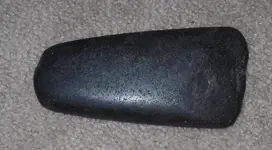oldbattleaxe
Sr. Member
I am sure I will get an answer on this on the forum. Along with it was a very nice authentic celt.
I know what fantasy piece means. Anything that is too good to be true is called that. When I get it in the hands of someone that knows about these I will post the results. Like unclemac posted, why would anyone go through the time and trouble to replicate this unknown piece when they could have spent their time taking the same effort to make an 8" spear point which is easily identified and get more money. I am convinced this spear is authentic but when, where, and why. I do appreciate all input but common sense stuff. If you know about anything old you can see the smootheness age and that is always what the experts preach. Thanks
I suppose you probably have not ever seen one of these either? I haven't. It is a real stone spear point. I stated many times that I appreciate the forums opinions and almost everything I have put on this forum has been resolved here. I personally feel this is not a fake piece and when I find out from an archeologist that I am supposed to take this item to I will post his opinion. The celt will be posted along with some of the other arrowheads he has. Thanks for your opinion as well as the others. Bill
I suppose you probably have not ever seen one of these either? I haven't. It is a real stone spear point. I stated many times that I appreciate the forums opinions and almost everything I have put on this forum has been resolved here. I personally feel this is not a fake piece and when I find out from an archeologist that I am supposed to take this item to I will post his opinion. The celt will be posted along with some of the other arrowheads he has. Thanks for your opinion as well as the others. Bill
I suppose you probably have not ever seen one of these either? I haven't. It is a real stone spear point...
I suppose you probably have not ever seen one of these either? I haven't. It is a real stone spear point. I stated many times that I appreciate the forums opinions and almost everything I have put on this forum has been resolved here. I personally feel this is not a fake piece and when I find out from an archeologist that I am supposed to take this item to I will post his opinion. The celt will be posted along with some of the other arrowheads he has. Thanks for your opinion as well as the others. Bill

 .
.